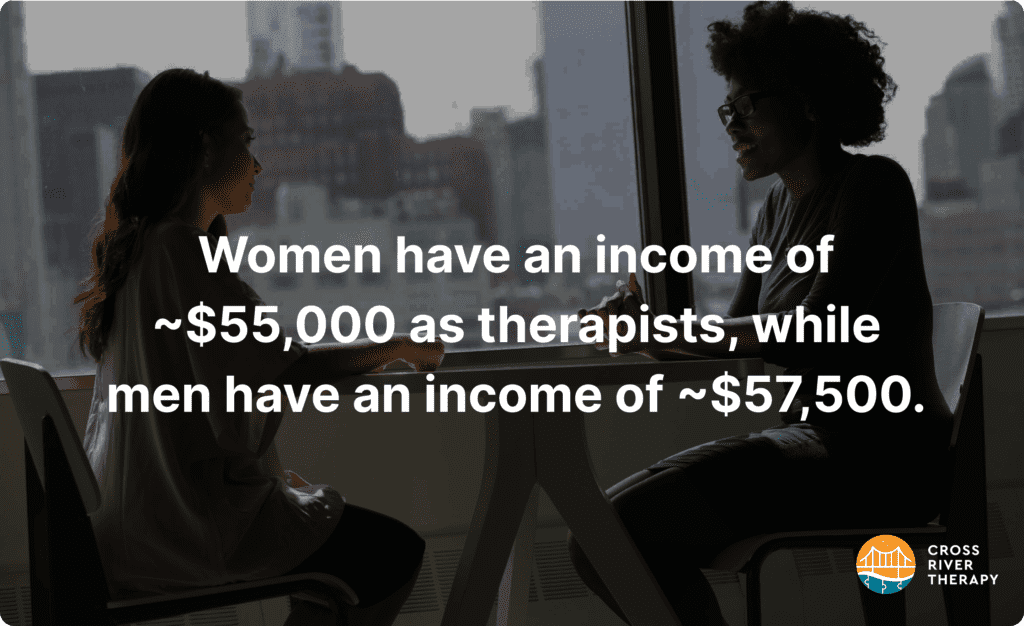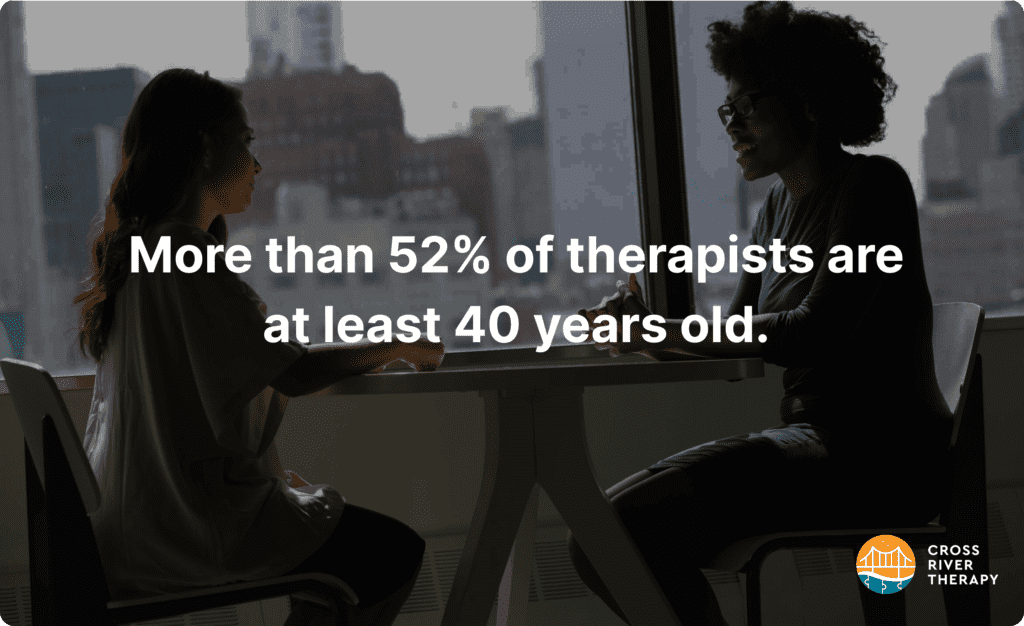Therapist Statistics And Facts: How Many Are There?
There are over 198,811 therapists currently employed in the United States. Find more therapy statistics below.

Number Of Therapists In The U.S.
- There are over 198,811 therapists and over 81,000 psychologists practicing in the US.
- Women make up over 70% of therapists and make 96 cents to a man’s dollar, a lower wage gap than in many other job fields.
- Psychologists with a doctorate degree make nearly twice as much on average as therapists.
- Women make up 58% of psychologists and make 94 cents to a man’s dollar, a wider but similarly low wage gap to therapists.
- The majority of therapists are white, but more than 10% are Asian.
- Psychologists are in the highest demand in Los Angeles County, while therapists are in the highest demand in coastal northern California.
- The majority of psychologists are white, but more than 10% are Hispanic or Latino.
- Therapists and psychologists are both in high demand in southern California and southern Arizona.
- The most commonly spoken foreign language for both therapists and psychologists in the U.S. is Spanish.
- California has the highest average pay for both therapists and psychologists.
- Therapists most commonly work with private companies, while psychologists most commonly work with educational institutions.

Chapter 1: Therapist Statistics by Gender
Gender Pay Gap for Therapists
- The gender pay gap for therapists is lower than in many other professions, with women earning 96 cents to a man’s dollar.
- Women have an income of about $55,000 as therapists, while men have an income of about $57,500.

Therapist Gender Over Time
- Therapy has been largely female-dominated since at least 2010.
- In 2014, men represented less than 25% of the total number of therapists in the U.S.
- In 2016 and 2018, men represented about 25% of the total number of therapists.
- Between 2010 and 2019, the gender ratio of therapists has changed by less than one percentage point.
Therapist Male to Female Ratio
About 70.4% of therapists are women, while about 24.7% of therapists are men. (The remaining 4.9% are practitioners of an unknown gender.)
Chapter 2: Therapist Statistics by Race
Therapist Race and Ethnicity Over Time
- In 2010, 79% of therapists were white. About 9.4% were Asian, 5.9% were Hispanic or Latino, and 3.9% were Black.
- By 2019, more than 10.6% of therapists were Asian, 6.4% were Hispanic or Latino, and 4.1% were Black.
- Every racial demographic except white people has grown since 2010, with white people making up just 76.4% of therapists in 2019.
Therapist Wage Gap by Race
- Therapists of Asian descent have the highest average salary in the U.S., making an average of about $59,100.
- Black people have the lowest average salary in the U.S., making an average of about $54,600.
- White people make an average of $55,700, while Hispanic or Latino people make an average of $55,900.
The average salary by race is also relatively close in margin compared to some other professions.
Chapter 3: Average Age of a Therapist
- The demographic with the highest average age is Asian people of any gender, with an average of 42 years old.
- The lowest age was for the unknown racial demographic, which has an average age of 33.
- Among known ethnicities, the lowest age is among Hispanic and Latino men, who have an average of just 38.5.
Therapist Age Breakdown
- Studies indicate that more than 52% of therapists are at least 40 years old.
- Another 34% of therapists are between the ages of 30 and 40.
- The lowest age demographic for therapists is those between 20 and 30 years old, making up just 14% of practitioners.

Chapter 4: Types of Therapist Degree Levels
- Nearly half of all therapists earn a Bachelor’s degree, with 47% of practitioners having this degree.
- Another 42% of therapist practitioners have a Master’s degree.
- About 6% of therapist practitioners have an Associate’s degree.
- The remaining percentage of therapists is made up of doctorate or other degrees.
Therapist Wage Gap by Education
- A Master’s degree has the highest earning potential for therapists, with an average salary of $55,200.
- A therapist with a Bachelor’s degree earns an average of $53,100, in comparison to $52,400 for therapists with a doctorate.
- The earning potential for therapists with a Master’s degree is significantly lower than the earning potential for Master’s degrees in fields like education.
Chapter 5: Therapist Employment Statistics
Company Size
- 28% of therapist positions are offered by companies with 500 to 1,000 employees, and another 28% come from companies with 1,000 to 10,000 employees.
- Companies with 100 to 500 employees offer 25% of therapist positions on the market.
- Companies with over 10,000 employees offer 7% of therapist positions on the market.
- Small businesses with less than 50 employees offer 7% of therapist positions, while medium businesses with 50 to 100 employees offer the last 6%.
Types of Companies That Therapists Work In
- The vast majority of therapists work in the private sector, with 74% of them working at a private company.
- Around 10% of therapists work in the public sector.
- Around 7% of therapists work for educational institutions, while 9% of therapists work for the government.
Top Industries Hiring Therapists
- Healthcare companies hire the most therapists, making up 36% of the total positions available.
- Nonprofits are the 2nd largest sector hiring therapists, making up 21% of the total positions available.
- All together, professional companies, pharmaceutical companies, and manufacturing companies offer about 19% of therapist jobs available.
Chapter 6: Therapist Turnover and Unemployment Statistics
- Because therapists are in such high demand, they have one of the lowest unemployment rates in the healthcare industry.
- Therapist unemployment rates have only been above 1% once in the decade preceding the COVID-19 pandemic.
Therapist Unemployment Rate Over Time
- In 2010, the therapist unemployment rate was 0.98%.
- The highest therapist unemployment rate between 2010 and 2019 was in 2012 at 1.2%.
- In 2019, the therapist unemployment rate jumped from 0.5% to 0.8%.
Average Number of Years That Therapists Stay in a Job
- Therapists do have a high turnover rate, with about 35% staying in a job for just 1 to 2 years.
- Another 24% of therapists quit their jobs after less than a year, meaning that over 50% of the population remains in one job for less than 2 years.
- 29% of therapists stay in one job for between 3 and 7 years.
- The lowest percentage for the average number of years is 7% for therapists who stay at one job for 11 years or more.
Foreign Languages Spoken by Therapists
- About 66% of therapists in the U.S. who speak a foreign language are fluent in Spanish.
- In the U.S., about 7.4% of therapists who speak a foreign language speak French.
- About 4.6% of U.S. therapists who speak a foreign language speak Swedish.
- The next two most common foreign languages for therapists to speak in the U.S. are German at 2.6%, and Portuguese at 2.4%.
Chapter 7: Therapist Jobs Statistics
Where Do Therapists Earn the Most?
- Therapists earn an average of over $63,000 in most Northern California counties on the West Coast.
- Therapists also earn an average of more than $64,000 throughout most counties in Alaska.
- Therapists throughout New Jersey have an average salary of over $62,000.
- The state in the U.S. with the lowest average therapist salary is Nebraska, where therapists make about $40,000.
Where Are Therapists Located?
Source: Zippia.com
- The densest therapist populations in the U.S. can be found in New York City and Philadelphia, Pennsylvania.
- Therapists are also densely located throughout southern California, southern Arizona, southern Florida, and along the East Coast from Maryland to Massachusetts.
- More densely populated areas tend to have larger numbers of therapists, with urban metro areas having the most.
Where Are Therapists in High Demand?
Source: Zippia.com
- Therapists are in the highest demand in southern California, southern Florida, and the Seattle metro area.
- There is also a high demand for therapists concentrated in the Northeast, with a much higher demand than population in rural New York and New Hampshire.
As with the therapist locations, demand for therapists tends to be most chiefly concentrated in urban areas. However, there is some marked demand for therapists in parts of the Midwest and Texas that don’t have a high overall population.
Chapter 8: Psychologist Statistics by Gender
Among Psychologists, 57.9% of them are women compared to 32.5% which are men.
Gender Pay Gap for Psychologists
- The gender pay gap for psychologists is slightly larger than for therapists, but still less than the average gender pay gap.
- Female psychologists make 94 cents for every dollar earned by male psychologists.
- Male psychologists make almost twice as much as male therapists, with an income of about $98,200.
- Female psychologists have an average income of about $92,300, significantly higher than the average wage for an average woman employed full time.
Psychologist Gender Over Time
- The genders of psychologists have fluctuated more since 2010 than the genders of therapists.
- In 2010, 57% of psychologists were women, while 43% were men.
- The highest number of female psychologists in the past decade was in 2017, when women made up 65% of psychologists to 35% of men.
- The highest number of male psychologists in the past decade was in 2018, when men made up 40% of psychologists to women’s 60%.
- Since 2012, women have fallen from 62% of practitioners to just 58% of psychologists.
-

Psychologist Male to Female Ratio
- Psychology is a female-dominated field, though the ratio isn’t as pronounced as with therapists.
- Around 58% of practicing psychologists are women, and 32.5% are men. The remaining 9.5% percentage is made up of psychologists of unknown gender.
Chapter 9: Psychologist Statistics by Race
- 79% of practicing psychologists are white, with the next biggest group being Hispanic or Latino practitioners at 10%.
- About 4.7% of the psychologist population is made up of Black practitioners, with another 4.2% being Asian practitioners.
- The lowest represented demographic in psychology is American Indian and Alaska Native individuals, who make up just 0.3% of total psychologists.
Psychologists are overwhelmingly white, with about 79% of practitioners being white. Asian psychologist practitioners are less than half as common as Asian therapists.
Psychologist Race and Ethnicity Over Time
- In 2010, white psychologists made up 81.7% of practitioners. This number fell slightly over the following years, until it rose to 81.9% in 2018.
- Between 2010 and 2019, the percentage of Hispanic or Latino psychologists rose from 8.2% to 10.1%.
- Between 2010 and 2019, the percentage of Asian psychologists rose from 3.4% to 4.3%.
- Between 2010 and 2019, the percentage of Black psychologists stayed nearly the same, going from 4.74% to 4.66%.
Psychologist Wage Gap by Race
- The ethnicity with the highest average salary for psychologists is Hispanic or Latino practitioners, who make $98,900.
- The average salary for Black psychologists is $95,600, for white psychologists is $95,400, and for Asian psychologists is $94,700.
- Psychologists of unknown race have the lowest salary average, with this demographic making just $91,500.
The average salary of psychologists by race is very close, indicating a high level of racial equality within the job field.
Chapter 10: Average Age of a Psychologist
- White men who are psychologists have an average age of 52, while white women have an average age of 44.
- Hispanic or Latino men who are psychologists have an average age of 44.5, while Hispanic or Latino women have an average age of 42.
- Asian psychologists have an average age of about 40, while Black psychologists have an average age of about 41.
The average age of psychologists can vary depending on gender and ethnicity. White men are the oldest average demographic by far. This might be because it was easier for white men to receive a psychology degree in the U.S. in the 1980’s and before.
Psychologist Age Breakdown
- Over 66% of psychologists are more than 40 years old. That makes up 2 out of every 3 practitioners.
- Almost 30% of psychologists are between 30 and 40 years old, meaning that over 95% of psychologists are at least 30 years old.
- A remaining 5% of psychologists are between the ages of 20 and 30.

Because psychologists need to study for so long, their average age is much higher than the average therapist. It’s rare for a psychologist to be under the age of 30.
Chapter 11: Types of Psychologist Degree Levels
- Nearly half of all psychologists practice with a Bachelor’s degree, with this demographic making up 47% of practitioners.
- About 26% of psychologists have a Master’s degree.
- Another 23% of psychologists practice with a doctorate degree, a significantly higher percentage than with therapists.
Psychologist Wage Gap by Education
- Psychologists with a doctorate degree have the highest average salary, making about $92,300.
- Psychologists with a Master’s degree make about $71,180 on average.
A doctorate degree is often what sets psychologists apart from their therapist counterparts. If you want to have the highest possible salary as a psychologist, then a doctorate degree is what you should pursue.
Chapter 12: Psychologist Employment Statistics
Company Size
- Nearly half of all psychologists are employed at companies with between 1,000 and 10,000 employees, with these companies accounting for 44% of positions.
- The second highest percentage of psychologist positions is offered by companies with 100 to 500 employees, at 1 out of every 5 jobs.
- About 15% of psychologist positions are at companies with 500 to 1,000 employees, and 12% are at companies with more than 10,000 employees.
- Just 6% of psychologist positions are offered by small companies with less than 50 employees, and 4% are offered by medium-sized companies with 50 to 100 employees.
Types of Companies Psychologists Work In
- Far more psychologists work in education than therapists, accounting for 43% of psychologist employment.
- Another 36% of psychologist employment is in the private sector.
- 19% of psychologist employment is at government institutions.
- The public sector makes up just 2% of psychologist roles, significantly less than the number of public therapist jobs.
Top Industries Hiring Psychologists
- As with therapists, healthcare is the largest sector hiring psychologists, accounting for 35% of positions.
- Education is the 2nd largest industry for psychologists, accounting for 1 in 4 positions.
- The government and nonprofit organizations make up a combined 18% of psychologist positions.
Chapter 13: Psychologist Turnover and Unemployment Statistics
Psychologist Unemployment Rate Over Time
- The highest psychologist unemployment rate in the U.S. between 2010 and 2019 was 1.58% in 2011.
- The lowest psychologist unemployment rate in the U.S. between 2010 and 2019 was 0.44% in 2018.
- From 2010 to 2019, the psychologist unemployment rate fluctuated but ultimately dropped from 1.2% in 2010 to 0.6% in 2019.
Average Number of Years That Psychologists Stay in a Job
- About 1 in 3 psychology positions is only held for 1 to 2 years, making up 32% of jobs.
- Another 17% of psychology positions last for less than a year, meaning that nearly half of all psychology jobs are left within 2 years.
- About 16% of psychology jobs have an average staying rate of more than 11 years.

Foreign Languages Spoken by Psychologists
- About 62% of psychologists who speak a foreign language are fluent in Spanish.
- Another 7.8% of psychologists who speak a foreign language are fluent in French.
- About 5.4% of psychologists who speak a foreign language are fluent in Portuguese.

Chapter 14: Psychologist Jobs Statistics
Where Do Psychologists Earn the Most?
Source: Zippia.com
- Psychologists earn the most in the U.S. in middle and southern California, with most counties having an average salary of over $96,000.
- Psychologists also make more than average in the Northeast, especially all of New England (excluding Maine) and New Jersey.
Where Are Psychologists Located?
Source: Zippia.com
- Psychologists are most densely located in middle and southern California, along with the coastal Northeast.
- There are also dense pockets of psychologists in urban areas of Texas, Michigan, and southern Florida.
Where Are Psychologists in High Demand?
Source: Zippia.com
- Psychologists are in the highest demand in the U.S. in areas like Los Angeles County, California, where there are over 2,000 job openings.
- Psychologists are also in high demand throughout southern California, southern Arizona, southern Florida, and the coastal Northeast.
- Dupage County in Illinois has over 2,500 job openings for psychologists, significantly higher than the rest of the state.
Sources
- https://www.zippia.com/therapist-jobs/demographics/
- https://psychcentral.com/blog/mental-health-professionals-us-statistics-2017
- https://www.apa.org/monitor/2016/03/datapoint
- https://www.bls.gov/ooh/life-physical-and-social-science/psychologists.htm
- https://www.cdc.gov/nchs/products/databriefs/db380.htm

Have Any Questions?
Whether you're curious about our services or need support, we're just a click away. Reach out or check our FAQs for quick answers.

